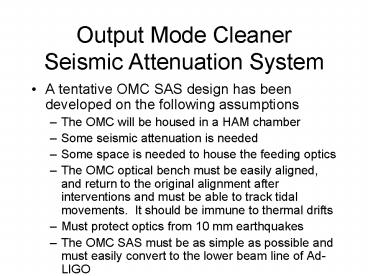Output Mode Cleaner Seismic Attenuation System PowerPoint PPT Presentation
1 / 8
Title: Output Mode Cleaner Seismic Attenuation System
1
Output Mode CleanerSeismic Attenuation System
- A tentative OMC SAS design has been developed on
the following assumptions - The OMC will be housed in a HAM chamber
- Some seismic attenuation is needed
- Some space is needed to house the feeding optics
- The OMC optical bench must be easily aligned, and
return to the original alignment after
interventions and must be able to track tidal
movements. It should be immune to thermal drifts - Must protect optics from 10 mm earthquakes
- The OMC SAS must be as simple as possible and
must easily convert to the lower beam line of
Ad-LIGO
2
OMC SAS
- Since we do not know yet the real estate
requirements of the feeding optics, I thought
that the most prudent policy is to base the work
around the present LIGO optical bench geometry - In any case the cost differential between a large
and a small seismic attenuation table is marginal
and there is advantage to work using a table that
everybody is comfortable with. - The complexity of handling a small and a large
table is the same with more legroom in a larger
structure - To minimize the complexity I kept the proposed
SAS design to a single stage of passive
attenuation
3
- Note for the reader, this and some other
transparencies are hidden slides, not used in
todays presentation. - Please use the slide show command not to see them.
4
OMC SAS
- The requirement of guaranteeing easy return of
the alignment after interventions require a set
of suitable UHV compatible sensors and actuators - The sensors will read the changes of position
after interventions and either suggest changes of
ballast to regenerate the previous balance, or
use the actuators to return to the original table
alignment - A set of LVDT, nanometer resolution, cm range,
UHV compatible position sensors are adequate for
the use. - Low power, UHV compatible voice coils are
suitable actuators to deal with tidal and thermal
position changes
5
OMC SAS
- The passive attenuation has been designed on the
basis of inverted pendula in the horizontal
direction and GAS springs in the vertical
direction - Both devices have been successfully used to
produce 60 or more dB of passive mechanical
attenuation
6
(No Transcript)
7
Shaker shaking tower
8
(No Transcript)
9
HAM implementation
Existing design optical bench
10
HAM implementation
- Horizontal direction, x, y, phi
- the IPs
Intermediate platform
legs
Flex joints
11
HAM implementation
- Preliminary test results
- 60 dB achieved without counterweight
- 1/8 payload (8 times better at full payload)
12
HAM implementation
- vertical direction, the GAS springs
Optical bench
Intermediate platform
GAS springs
13
HAM implementation
- The transition between
- LIGO and Advanced LIGO is obtained by simply
eliminating a number of spacers
14
HAM SAS feature
- The expected passive attenuation performance is
probably good enough for the OMC - The sensors and actuators satisfying by the
positioning, tidal and thermal stability
requirements are compatible with active
attenuation - The performance of HAM-SAS can be complemented
with one stage of active attenuation at marginal
cost - This addition would make the OMC HAM SAS a
viable, more inexpensive candidate to replace the
in-vacuum stiff SEI and is fully compatible with
the SUS system
15
HAM SAS design status
- A practically complete tentative HAM SAS design
is virtually ready for production - http//www.ligo.caltech.edu/desalvo/HAM-SAS
and - http//www.ligo.caltech.edu/desalvo/HAM-SAS.doc
- Preliminary bidding indicate a mechanical
components cost of 130K (including optical
bench, excluding accelerometers and motors) with
production time of the order of three months - Prototyping of parts of the design will be made
shortly, fully validating the design - Scaling of the design is possible both for
smaller sizes, if deemed necessary, or for larger
sizes (BSC)

